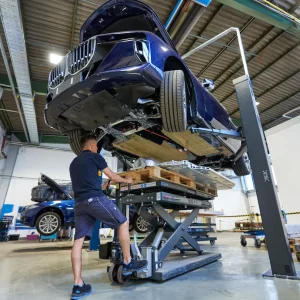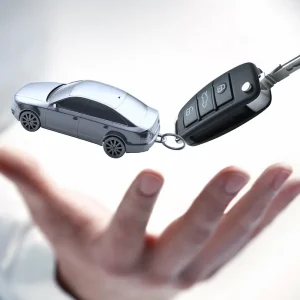
The biggest challenge is the logistics of taking people out of the business to attend a training course. It is tough. You’re trying to run a business and, it doesn’t matter how big or small that business is, you take key players out and you’ve got a major problem.”
That is Driver First Assist CEO, David Higginbottom, on what he and others consider the chief obstacle to putting employees through driver training. Downing tools to hit the road with an instructor or tuck yourself up in a classroom, while valuable, just isn’t practical for a lot of employees, especially if driving is core to their job and they are rarely in one place for long.
Throw in hybrid working, now standard issue for many businesses, and even a relatively static office-based staff is tricky to round up. It is not hard, then, to see why specialists have increasingly launched alternatives to in-person coaching.
Online formats, often referred to as e-learning, are nothing new, but they are now applied far more extensively and in a plethora of guises. TTC Group and Red Driver Training estimate that around 70-75% of their training is now online, and for those who associate it with the ‘click the screen’ style of the early digital section of the driving theory test – typically administered via a boxy monitor at a DVLA office – rest assured that it has progressed.
Webinars are popular with fleets, because they represent an accessible straight swap for classroom training, but individual sessions are where the real development has taken place. The TTC Group, for example, has a series of micro modules ranging from around five to 15 minutes, designed for when employees can snatch a moment.
“These usually come in forms of bundles,” explains deputy chair, Jim Kirkwood, “if you think about speeding, the first one would be speed limit recognition: how do you know if you’re in a 30mph zone, or a 40, or a motorway? So we’ve got a quick module on effective speed management.
“When we deploy these micro modules, we usually do it over several weeks. So with a bundle of, say, five modules, we would probably say to the driver, ‘you have got to do one of these, once a week, over five weeks. Once the driver has completed them, they will know what to do when they’re in a 30mph zone, they’ll have a better understanding of safe following distances and hazard awareness.”
Red Driver Training overhauled its e-learning programme with a similar emphasis on digestibility. Previously, it offered text-based online coaching, which required drivers to read content and followed up with a Q&A, but it switched to an audio-visual format after it noticed the compliance rate was falling.
“Not many people actually completed it,” says head of corporate training, Greg Ford, “so we recognised that and moved to video-based training. There’s a lot of evidence that watching and listening is a really good way for most people to learn, so we now do e-learning by videos with a question set afterwards, and the compliance levels. have gone from about 35% to 80% completion.
“The engagement is so much better, because. we’re all used to watching YouTube videos and things like that. It’s familiar territory. Before, we were expecting people to read probably 300-500 words. Now, they can just watch it on their phone, on a tablet, wherever they want at any time they want.”
Driver First Assist has recently launched its inaugural online course after a decade specialising in full-day, classroom-based training sessions, and its USP is explaining to anyone driving for work what they should do if they are first on the scene of an accident.
There is now a compact, hour-long digital version of the physical course. Known as Skills for Safer Journeys, it is condensed into seven sections, each capped with a short assessment. Higginbottom says its purpose is to reach drivers for whom time out of the working day is rarely an option, particularly the oft-neglected grey fleet population, and it chimes with Red and TTC’s ‘watch it whenever you want’ ethos.
“The Health and Safety Executive’s ‘Driving and riding safely for work’ document very clearly states that businesses should consider that drivers have the appropriate skills for assessing risks while out on the road,” he explains, “to be able to do that, you’ve got to have some mechanism for risk assessing people’s skills, and the traditional way for that will be through a training needs analysis.
“Are businesses doing that routinely? No way. I think that health and safety for drivers is generally flying under the radar because . there is not the same policing of health and safety on the road network for drivers as there is for a conventional workplace.”
Given their meteoric rise courtesy of the pandemic and online shopping boom, delivery fleets are where a lot of training specialists have focused their efforts, and it is a big part of the reason behind TTC’s micro courses.
“With certain roles, like multi-drop drivers, that training [becomes] part of their day job. It’s not something we’re saying you’ve got to take a half or a whole day out, but they do have the ability to determine when during the day they do it – when they’re having a tea break or something like that.”
Some providers are now conducting in-person training on the job, dispatching coaches to ride along with mobile employees and instruct them during the working day.
“With some of our customers, we actually offer the training while they’re doing the job,” says Drivetech’s commercial consultant, Anthony Marcou, “an example of that is in the supermarket sector. We’re quite strong in that industry and we do the courses while the agents are doing their deliveries.”
Drivetech was the only organisation we spoke to that reported a rise in in-person training this side of the pandemic, and its ‘while-you-work’ technique could well be a part of that, but the approach divides opinion among trainers. Ford considers it ineffective when short-hop deliveries are involved, and thinks it only works when the driver is at the wheel for an extended period.
“We get quite a lot of clients that say, ‘can you do training on the job?'” he explains, “the answer, nine times out of 10, is no. We need this driver to concentrate on this coaching [and] we can’t have them jumping in out of the van on a multi-drop route. but there is the odd occasion, depending on what the organisation does, where we can do on-the-job training when they’re driving a certain distance.”
As with the move to video-based courses, gamification is forming an ever-bigger part of remote training. It is nothing new – league tables and awards for the best drivers have long been informed by telematics feeds – but consider how many apps now reward us for repetitive engagement (and not just for addictive scrolling – language learning app Duolingo is a good example of noble encouragement) and it stands to reason that driver training should follow.
Drivetech’s Brightmile app is one example: “It shows the driver their performance,” says Marcou “at the same time, there’s driver coaching that sits behind it. you’re kind of up against yourself, thinking, ‘wait a minute, I’ve done a bit too much speeding or harsh accelerating today; I’ll try and rectify that tomorrow,’ and you get little badges for doing so.”
It is far from alone. Fleet industry favourite Lightfoot’s dashboard device is another example of an in-cab prompt to nudge drivers into better habits, complete with competitions and prizes for the best performers. At the futuristic end of the spectrum, camera-based telematics systems can now use AI to identify transgressions. Typically the preserve of the commercial vehicle sector, they instantaneously tell the driver when they spot bad behaviour and give them a chance to curtail it before alerting the fleet manager.
Teletrac Navman’s Smart Dashcam is among the kit that can effectively conduct a portion
of training in the cab in direct response to drivers’ behaviour.
“It’s an audible alert [from the camera] and it will be descriptive of what you are doing incorrectly,” explains product manager, Barney Goffer, “for example, ‘please slow down’ if you are speeding, and that’s linked to the vehicle type you are driving and the road speed network.
“Your first one is a warning… to say take preventative action. The next alert means you’ve not taken preventative action and a message has been sent back to the user interface and recorded. What we’ve tried to say is, ‘look, we want to give you the chance to take action yourself and handle that without the need to be debriefed’.”
Telematics is also used to inform the types of training administered to drivers. Many of the big providers comb data feeds to find out which drivers need help with what.
“We bring in fuel data, information about your driving licence, accidents, and other risk areas, then start to profile the driver from different mediums, rather than just having one particular feed,” explains Marcou, “there’s an opportunity there to match up our e-learning to the outputs and training requirements from telematics feeds.”





